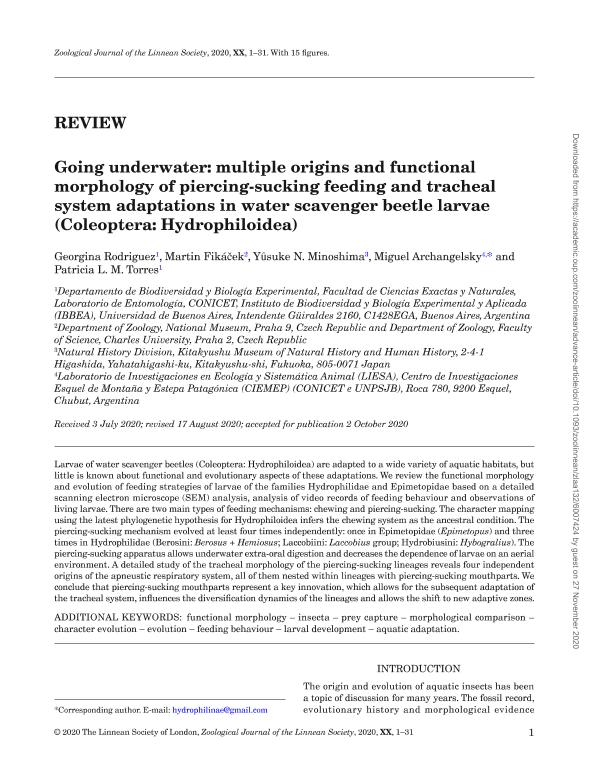Mostrar el registro sencillo del ítem
dc.contributor.author
Rodriguez, Valeria Georgina

dc.contributor.author
Fikácek, Martin
dc.contributor.author
Minoshima, Yusuke N
dc.contributor.author
Archangelsky, Miguel

dc.contributor.author
Torres, Patricia Laura Maria

dc.date.available
2021-08-31T18:58:57Z
dc.date.issued
2021-09
dc.identifier.citation
Rodriguez, Valeria Georgina; Fikácek, Martin; Minoshima, Yusuke N; Archangelsky, Miguel; Torres, Patricia Laura Maria; Going underwater: Multiple origins and functional morphology of piercing-sucking feeding and tracheal system adaptations in water scavenger beetle larvae (Coleoptera: Hydrophiloidea); Oxford University Press; Zoological Journal of the Linnean Society; 193; 1; 9-2021; 1-30
dc.identifier.issn
0024-4082
dc.identifier.uri
http://hdl.handle.net/11336/139362
dc.description.abstract
Larvae of water scavenger beetles (Coleoptera: Hydrophiloidea) are adapted to a wide variety of aquatic habitats, butlittle is known about functional and evolutionary aspects of these adaptations. We review the functional morphologyand evolution of feeding strategies of larvae of the families Hydrophilidae and Epimetopidae based on a detailedscanning electron microscope (SEM) analysis, analysis of video records of feeding behaviour and observations ofliving larvae. There are two main types of feeding mechanisms: chewing and piercing-sucking. The character mappingusing the latest phylogenetic hypothesis for Hydrophiloidea infers the chewing system as the ancestral condition. Thepiercing-sucking mechanism evolved at least four times independently: once in Epimetopidae (Epimetopus) and threetimes in Hydrophilidae (Berosini: Berosus + Hemiosus; Laccobiini: Laccobius group; Hydrobiusini: Hybogralius). Thepiercing-sucking apparatus allows underwater extra-oral digestion and decreases the dependence of larvae on an aerialenvironment. A detailed study of the tracheal morphology of the piercing-sucking lineages reveals four independentorigins of the apneustic respiratory system, all of them nested within lineages with piercing-sucking mouthparts. Weconclude that piercing-sucking mouthparts represent a key innovation, which allows for the subsequent adaptation ofthe tracheal system, influences the diversification dynamics of the lineages and allows the shift to new adaptive zones.
dc.format
application/pdf
dc.language.iso
eng
dc.publisher
Oxford University Press

dc.rights
info:eu-repo/semantics/openAccess
dc.rights.uri
https://creativecommons.org/licenses/by-nc-sa/2.5/ar/
dc.subject
FUNCIONAL MORPHOLOGY
dc.subject
INSECTA
dc.subject
PREY CAPTURE
dc.subject
MORPHOLOGICAL COMPARISON
dc.subject
CHARACTER EVOLUTION
dc.subject
EVOLUTION
dc.subject
FEEDING BEHAVIOUR
dc.subject
LARVAL DEVELOPMENT
dc.subject
AQUATIC ADAPTATION
dc.subject.classification
Zoología, Ornitología, Entomología, Etología

dc.subject.classification
Ciencias Biológicas

dc.subject.classification
CIENCIAS NATURALES Y EXACTAS

dc.title
Going underwater: Multiple origins and functional morphology of piercing-sucking feeding and tracheal system adaptations in water scavenger beetle larvae (Coleoptera: Hydrophiloidea)
dc.type
info:eu-repo/semantics/article
dc.type
info:ar-repo/semantics/artículo
dc.type
info:eu-repo/semantics/publishedVersion
dc.date.updated
2021-08-27T20:20:59Z
dc.identifier.eissn
1096-3642
dc.journal.volume
193
dc.journal.number
1
dc.journal.pagination
1-30
dc.journal.pais
Reino Unido

dc.journal.ciudad
Oxford
dc.description.fil
Fil: Rodriguez, Valeria Georgina. Consejo Nacional de Investigaciones Científicas y Técnicas. Oficina de Coordinación Administrativa Ciudad Universitaria. Instituto de Biodiversidad y Biología Experimental y Aplicada. Universidad de Buenos Aires. Facultad de Ciencias Exactas y Naturales. Instituto de Biodiversidad y Biología Experimental y Aplicada; Argentina
dc.description.fil
Fil: Fikácek, Martin. Karlova Univerzita (cuni); República Checa
dc.description.fil
Fil: Minoshima, Yusuke N. Kitakyushu Museum of Natural History and Human History; Japón
dc.description.fil
Fil: Archangelsky, Miguel. Consejo Nacional de Investigaciones Científicas y Técnicas. Centro Científico Tecnológico Conicet - Patagonia Norte. Centro de Investigación Esquel de Montaña y Estepa Patagónica. Universidad Nacional de la Patagonia "San Juan Bosco". Centro de Investigación Esquel de Montaña y Estepa Patagónica; Argentina
dc.description.fil
Fil: Torres, Patricia Laura Maria. Consejo Nacional de Investigaciones Científicas y Técnicas. Oficina de Coordinación Administrativa Ciudad Universitaria. Instituto de Biodiversidad y Biología Experimental y Aplicada. Universidad de Buenos Aires. Facultad de Ciencias Exactas y Naturales. Instituto de Biodiversidad y Biología Experimental y Aplicada; Argentina
dc.journal.title
Zoological Journal of the Linnean Society

dc.relation.alternativeid
info:eu-repo/semantics/altIdentifier/url/https://academic.oup.com/zoolinnean/advance-article/doi/10.1093/zoolinnean/zlaa132/6007424
dc.relation.alternativeid
info:eu-repo/semantics/altIdentifier/doi/https://doi.org/10.1093/zoolinnean/zlaa132
Archivos asociados
